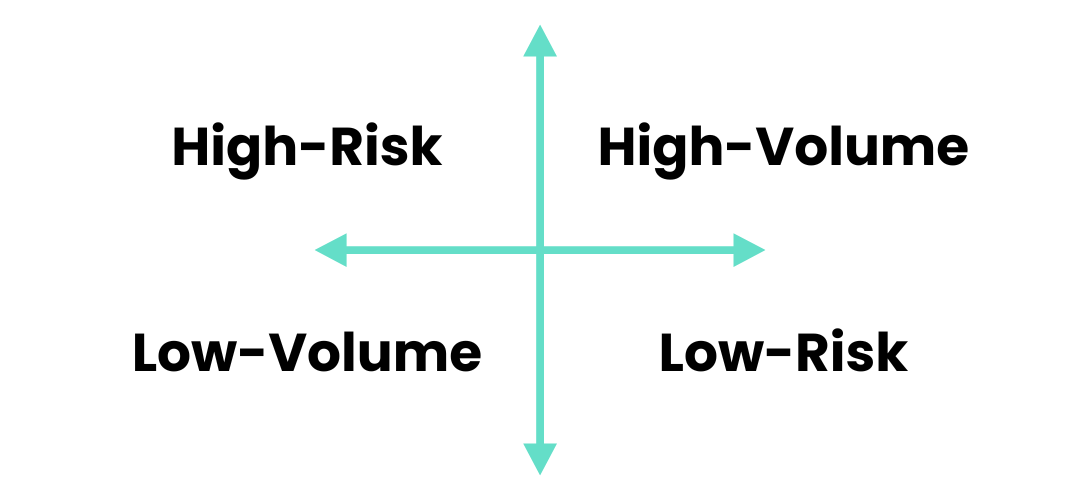2024 Law Firm Billing Rate Increases: Why Rates Rose and How to Negotiate Lower Fees
The average law firm billing rate increased 4.8 percent in the last year, according to our rates survey of the top 100 U.S. firms as ranked by The American Lawyer.
The good news is that the rate increases are not as steep as some legal industry experts anticipated.
The bad news? Rate hikes likely aren’t over yet in 2024.
Since hourly rates are a key drive of in-house legal spend, knowing why rates jumped and how to negotiate discounts is critical to your cost control strategy in 2024 and beyond.
Why Law Firm Billing Rates Went Up
Most legal professionals attributed last year’s jump to an increase in the cost of business, a rise in associate salaries, and a drop in the volume of work performed by law firms.
Higher Costs
Last year, rising interest rates and high inflation drove up the cost of doing business. Law firms raised rates to compensate.
Those national economic pressures were compounded by rocketing salaries, largely driven by a tight labor market for new associates. The expected salary rate of a first-year law associate at the largest, most prestigious U.S. law firms is up 17 percent since 2021, while other countries, such as the UK, have seen a similar increase.
Less Work
The turbulent 2023 economy hit law firm profitability unevenly. Transactional work like mergers, acquisitions, and real estate purchases dropped precipitously, while counter-cyclical legal work like bankruptcies increased.
Overall, this led to a drop in productivity, which showed up in the data as fewer billable hours across the legal industry. Again, many firms dealt with this by raising rates.
The Three Biggest Factors In Law Firm Billing Rates
While the vagaries of a turbulent economy account for some of the outsized increase in law firm billing rates last year, much of the difference in cost between firms is baked into just three factors.
Firm Size
The size of the firm you engage indicates their market power and their ability to command higher rates. The top 25 firms in the U.S. charge double their peers lower down the Am Law 100 list. These high-grossing big law firms attract some of the best lawyers in the world, but you’re paying for both the expertise and the brand.
Practice Area
The complexity of the work is another fundamental piece in the billing rates puzzle. High-stakes and complex work like business deals and litigation cost companies more than work like intellectual property filings.
Geography
A firm’s top billers tend to be located in a country’s most expensive cities, and law firm billing rates reflect the cost of living.
For example, our study shows rates for New York-based fee earners are more than double what you’ll find among Midwest-based law firms.
5 Ways To Negotiate Lower Fees
While rates continue to climb year after year, your in-house law department should negotiate and manage legal spend instead of meekly accepting large increases. The market has responded to escalating legal industry fees with an array of flexible pricing structures, alternative professional services, and legal tech.
A blend of these approaches will help you find different options for meeting your legal services needs and give you leverage when negotiating rate increases with your outside counsel.
1. Insourcing
If you don’t send work to law firms, then you don’t have to worry about what hourly rates they charge.
Of course, this logic has limits. The volume of work for most in-house teams could never be completed strictly within the walls of the corporate legal department.
However, the cost of an internal hour of work is typically significantly lower than the same hour of work performed by outside counsel. So, it is useful to periodically revisit your rules of engagement and make sure you’re not relying too heavily on outside counsel.
One helpful framework is a simple four-box grid that categorizes legal work by risk and volume.

High Risk, Low-Volume Work
High-risk and low-volume work is typically the best match for outside counsel engagement. In this quadrant, in-house subject matter expertise tends to be lower (as is the value of developing it), and the cost of errors is higher.
For example, pinching pennies on complex, bet-the-company litigation is never a savvy strategy.
High Risk, High-Volume Work
High-risk, high-volume work, by contrast, should make up the bulk of in-house assignments. In this quadrant, developing (or hiring) internal subject matter expertise is typically the most cost-effective play, considering how frequently that specialized knowledge will be used.
The risk profile of this work also merits internal oversight, as in-house staff have intimate knowledge of the risk apetitie and business goals of your organization. In the case of media brands, for example, a strong roster of in-house intellectual property experts is often a smart investment.
Low-Risk Work Of Any Volume
It’s the remaining two quadrants where you’re likely to find the majority of creative cost-saving opportunities. Since low-risk work is inherently less risky, regardless of volume, you can safely consider assigning it to someone who is neither an in-house attorney nor a law firm staffer.
This might mean partnering with an alternative legal service provider (ALSP) that can cost-efficiently absorb much of the document review work associated with compliance audits. Or it might mean using contract management to automate the review of processing of standardized, high-volume contracts.
In each case, creatively resourcing low-risk work saves in-house attorneys time they can then spend insourcing more of the high-risk work formerly led by law firms.
It’s also worth revisiting your resourcing mix as the goals of your company and the work of your legal team change.
It might be the case that you previously had a low volume of matters related to regulatory advice that you instructed out to your top firms. If your industry becomes more heavily regulated and the volume of regulatory matters increases, you should consider if you can insource this work at a lower cost or instruct it to a lower-cost legal service provider.
2. Tap Into Multiple Law Firm Tiers
Now that you’re feeling more confident about your balance of in-house and external resources, you can focus on finding the right law firms to fit the legal services you need. Just be careful not to narrow your gaze too closely as you do; the Am Law 100 or even the Am Law 200 list is far from the only place to look for the services you require.
Does the matter demand highly specialized expertise? Is work high-risk enough to need only the field’s top experts? If so, then you very well may be recruiting from the right tier.
But not all matters present equally complex or unique challenges.
So, challenge yourself to cast a wider net. Valuable advice and satisfying results can be sourced from all levels of law firm ranking, including from regional and boutique firms.
3. Instruct Work To Lower Cost Locations
Not every top-tier firm or fee-earner is in New York, D.C., or San Francisco.
One way to combat increasing rates is to move some of your work to outside counsel teams in smaller, less expensive cities.
This isn’t always possible. It makes sense to handle litigation in the state where the lawsuit was filed. And some complex regulatory matters are best handled by attorneys with expertise in those local laws.
But you can find savings on general legal advice and standard work like patent filings by widening your scope beyond the country’s largest metros.
4. Negotiate Beyond The Hourly Rate
Let’s imagine that you now have the rate list of your chosen law firm up on your monitor. And let’s assume, just for the time being, that the figures you see on the screen are set in stone.
Even in this scenario, there is still more financial control to explore than you might imagine.
Modifying Timekeeper Roles
One underused tactic involves modifying timekeepers’ roles rather than their rates.
Maybe you’re convinced that a certain partner is undoubtedly worth their hourly rate, but you suspect that the bulk of the work on the matter only requires an associate’s level of expertise.
Advocating for a restyled staffing strategy in this scenario could not only prove cost-effective for you, it may also be a welcome suggestion to a firm eager to develop the skills of its associate attorneys and preserve the bandwidth of its partners.
So be sure to collaboratively map out the staffing plan at the start of each outside counsel engagement—and don’t hesitate to underscore potential cost-optimization opportunities you see. Your historical spend data can help here in defining the best partner-associate mix for particular types of work.
Alternative Fee Arrangements
The more commonly discussed tactic to explore at this stage is alternative fee arrangement (AFA) negotiation. By definition, these conversations sidestep the notion of hourly billing rates altogether and tie work to a different pricing model, such as fixed prices and contingency fees.
The relatively infrequent adoption of AFAs industry-wide speaks to the challenge of matching work types to fee structures. However, there are more than a few scenarios where the financial incentives are suitably attractive to both sides. Plus, even if your total cost savings are negligible, cost predictability can be a victory in its own right.
5. Reinforce Your Cost Control Systems
Partnership agreements always look good on paper. But once matters are in motion, deviations from the original plan are an unfortunately common occurrence.
Outside Counsel Guidelines
Clearly documented and consistently enforced legal billing guidelines are the best way to ensure that law firms bill only at agreed rates and for work that delivers value to your business.
They anticipate potential sources of confusion or conflict and provide standardized guidance. This ensures the overwhelming majority of billed services conform to client expectations and are paid without drama or delay.
The best way to enforce these outside counsel guidelines is with a legal billing system like Brightflag. Brightflag uses artificial intelligence to instantly read the hundreds of line items in an invoice. It then objectively categorizes the work performed.
Next, it automatically rejects any line items that violate your billing rules and sends them back to the firm for correction.
Finally, it notifies the reviewer of guideline violations and anomalies that deserve a closer look and human judgment.
For example, Brightflag might catch that two timekeepers both billed hours for being at the same meeting and flag this for your attention. Then, it might highlight that an associate performed research. Your billing guidelines might prohibit basic research, and the system lets you confirm whether the billed research was appropriate before approving it.
Enforcing Rates and Budgets
In addition to systematically verifying the validity of each service, your legal billing system can create protocols for timekeeper rate adjustments, ensuring you can review and approve any requests for rate increases, armed with information on when the last increase was approved and the percentage uplift the firm is seeking. It can also alert all parties to impending budget overruns to ensure costs are kept on track.
Take Control of Rates with Brightflag
To effectively control law firm rates, you need a system of record for legal spend. That’s where a legal spend management system like Brightflag truly shines.
Brightflag helps you understand what you’re currently charged for legal work, and to set and enforce reasonable limits on rate increases.
It also goes a step further by leveraging your own spend data and industry benchmarks to help you negotiate optimal rates with your existing firms, and to identify areas where work can be insourced or moved to lower-cost providers, all while ensuring you deliver the same business outcomes.
The effectiveness of your execution grows in direct proportion to the depth of data you have.
Contact our team today, and we’ll coordinate a personalized tour of our leading legal spend management platform and show you how Brightflag enables to take control of law firm rates.



